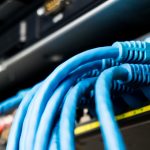
High Fiber Optic Speeds are Driving Connected Technologies
Fiber optics has become a bit of a buzzword, almost click-worthy just upon sight. Yet, there are good reasons for that, and it’s becoming the most-desired telecommunications medium available. It’s being used even for last-mile connections where the cost is justified, and dark fiber is being laid by the mile around the world to provide extremely fast and secure wide area networks (WAN) for major consumers, such as large companies and some government agencies.
New Speeds
Thanks to the ability of light pulses being able to transmit so much lossless data, each tiny fiber, usually around the size of a human hair, can carry the equivalent of 10 million POTS (plain old telephone service) voice calls. Bundled together, fiber services have the real-world ability to convey 1,000 Mbps, nearly 10 times the capacity of cable internet. Beyond this, a theoretical maximum of around 2 Pbps (petabits per second) per fiber exists, so this remarkable technology has a lot of room to grow.
5G Is Coming
With a latency below 1 millisecond, 20 Gbps ideal peak speed, and 10 times the connection density of 4G, 5G offers a completely wireless world for end users. However, an extensive fiber optic backhaul is needed to achieve this goal. Homes and businesses will no longer be concerned with last-mile connections, 4K video will be streamable by all consumers wherever an adequate 5G signal exists, and strong competition should keep the costs low. Real-world speeds averaging up to 10 Gbps should be obtainable by consumers.
5G is one of the ways fiber optics is revolutionizing the world. The high speeds mean that the Internet of Things (IoT) can include virtually all mechanical and digital devices without human interaction. Smart cities will use the exceptional data collection ability and IoT to utilize their resources far more economically, reduce costs and waste, and provide superior services to their citizens.
Coaxial cables, such as those used for cable connections, are currently the big lumbering bear in the field. Formerly considered high speed (compared to POTS connections), companies that still rely on coaxial for data are being left far behind. Coaxial cables are also more susceptible to electromagnetic interference and have a shorter transmission distance.
A strong fiber optic backbone is therefore essential for tower-to-tower and tower-to-network connections. With more concurrent connections available, it’s literally the only choice for the modern world.
Ease of Installation
Fiber can be installed using trenchless technology that won’t disturb landscaping or require removing other infrastructure. With advanced directional horizontal drilling machines, fiber can be installed beneath buildings, roads, environmentally sensitive areas, and even bodies of water using the minimal impact concept. Existing power or water lines aren’t touched, and the bore head is precisely controlled using several types of sophisticated locating devices, so unwanted damage is almost unheard of. Fiber can also be installed using traditional methods, such as aerial wiring and trenches, reducing costs even more.
Turn-key Solutions
To achieve top speeds and maximize return on investment when you need to create, extend or improve your network, you need an experienced company to provide a comprehensive range of solutions for construction and maintenance of fiber optics. From laying new lines, testing and splicing, and network support, it’s best to choose a contractor who can provide all your telecommunications needs for ideal compatibility and simplicity.
Check out our last post: 7 Benefits of Fiber Optics for Businesses





No Comments